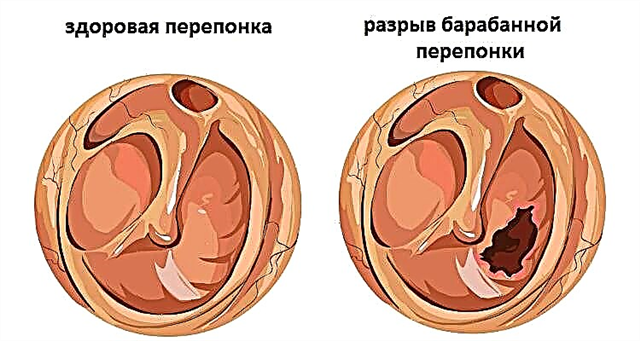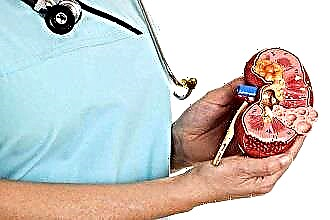Pulling pain in the heart can be a sign of not only cardiogenic and vascular pathologies: in 45-50% of cases, this symptom hides a disease of the nervous or respiratory system, and sometimes even acute pancreatitis. As practice shows, patients seek help only with a strong dagger attack, while the aching nature of the sensations behind the breastbone rarely makes them go to the doctor. In this article I want to talk about the causes of discomfort and first aid at home.
Causes
I think you have heard more than once that pulling pain in the region of the heart turned out to be a symptom of osteochondrosis, and the strongest discomfort in the stomach served as a herald of a heart attack. Why is there such confusion? The answer must be sought in the peculiarities of human intrauterine development.
The organs of the chest, neck and upper abdominal floor are formed at approximately the same time, and are located very close to each other. Accordingly, the centers in the spinal cord that regulate their work are also closely localized. The pain impulse can easily jump from top to bottom or vice versa. That is why unpleasant sensations behind the breastbone only in half of the cases indicate cardiogenic or vascular pathology.
Cardiac and vascular pathologies
The palm among pathologies accompanied by a pulling pain in the heart region, of course, belongs to cardiogenic and vascular diseases. I note that some of them are manifested by constant discomfort behind the sternum, while others are characterized by paroxysmal flow.
The table shows the main diseases in which this clinic occurs, as well as additional symptoms that allow them to be differentiated.
It appears against the background of ischemic disease at a time when the cells lack oxygen. Both "clogging" of the coronary arteries with atherosclerotic plaques and their spasm can lead to the appearance of such pain in the heart. Usually, the pathology manifests itself as a pressing sensation, but in some cases there is an aching or pulling feeling to the left of the sternum. | |
The atypical course of the disease can debut with dull, rather than sharp, dagger pain. At the same time, taking "Nitroglycerin" does not eliminate the symptom. Anxiety, fear and severe shortness of breath appear. Finding a comfortable body position in this situation is useless, as there is no relief. | |
A pathology in which the membrane, or bag, of the heart becomes inflamed - the pericardium. The reason lies in an infectious or autoimmune process. In addition to pulling deep pain, fever, shortness of breath, and coughing occur. Often the disease is preceded by ARVI or heart attack. | |
Nosology, characterized by the appearance of a protrusion in the weak spot of the aorta (aneurysm), after which blood begins to accumulate between the layers of the wall of this sac, gradually pushing them apart. The danger of pathology is that it is asymptomatic before delamination, and only a few hours can pass from the development of the first signs to the moment of rupture of the vessel and massive hemorrhage. The disease in some patients is accompanied by severe pulling pain in the region of the heart, radiating to the arm, jaw, and neck. Also, there is a blue face, swelling of the veins of the upper half of the body. |
Neurological diseases
Based on my experience, I can say that neurological pathologies become the cause of pulling pain in the heart, namely:
- Osteochondrosis of the thoracic spine. When the spinal root is compressed by a hernia or protrusion, the pain impulse can spread to the centers that are responsible for the innervation of the heart. Therefore, there is a feeling of constant discomfort behind the sternum of a aching character. How to distinguish osteochondrosis pain from a heart problem, read here.
- Intercostal neuralgia. Compression of this nerve can occur near the spine, or near the sternocostal joint. The latter situation will create the illusion of pain under the heart or directly in it. How to carry out differential diagnostics and determine the source of discomfort is written here.
- Vegetovascular dystonia. The existence of this diagnosis is still disputed, since, despite the presence of complaints and, often, vivid symptoms, no organic pathology of the nervous system is detected. Only the dysfunction of its autonomous center, which regulates the work of internal organs, is revealed. The course is usually paroxysmal and, in addition to drawing pain in the heart, shortness of breath, pressure fluctuations, sweating, hot flashes may be present. Below the link, we posted a video in which our expert explains in simple words what an IRR is and how to live with it.
- Neurosis. The borderline state between neurology and psychiatry. A person, roughly speaking, invents a disease for himself, the symptoms of which can change with lightning speed. Describing his condition, the patient may complain of pain in the region of the heart, first of a stabbing nature, and after five minutes they will already be pressing and accompanied by interruptions in the pulse.
Expert advice
I want to share with you information about a number of signs that will distinguish the cardiogenic character of an attack from a neurological one. The first thing to look out for is soreness near the spine or in the intercostal spaces. With cardiac pathologies, it is absent. An equally important factor is the presence of hemodynamic changes (fluctuations in heart rate and blood pressure), which in 99% of cases are mandatory companions of heart attack and angina pectoris.
Respiratory system diseases
Do not be surprised if the cause of the pulling pain in the region of the heart is a disease of the bronchi, lungs or pleura, the membrane covering them.
Among the pathologies of the respiratory system, manifesting this symptom, one can distinguish:
- Pneumonia. If the inflammation is located in the lower lobe of the left lung, then the clinic may well mimic cardialgia. But at the same time, there is a cough, an increase in body temperature, pronounced weakness and intoxication syndrome.
- Lung abscess, which is on the left, also often manifests itself as pain in the region of the heart, especially if it "props up" the pleura and has almost reached the stage of rupture. The disease is accompanied by fever, occasionally cough, aches.
- Tumor. In addition to discomfort behind the sternum, the neoplasm is characterized by weight loss, nausea, and increased fatigue. The unpleasant sensations are worse when you try to take a deep breath or cough.
- Pleurisy, or inflammation of an infectious, and sometimes autoimmune genesis, a film lining the inside of the chest, can also be hidden behind a pulling pain in the region of the heart. It grows when breathing, turning and is accompanied by general intoxication and fever.
Problems with the digestive system
Feeling periodic discomfort under the heart of a aching or pulling character, which is associated with food intake, you should think about the pathology of the digestive system. The illusion of heart disease can be created by:
- gastritis;
- stomach ulcer;
- pancreatitis, both acute and chronic exacerbation;
- gastroesophageal reflux disease, in other words, the reflux of gastric contents into the esophagus.
I want to draw your attention to the fact that such pain in the heart will be accompanied by heartburn, flatulence, nausea, stool disturbance and other dyspeptic disorders.
Diagnostics
Diagnosis of diseases manifested by unpleasant sensations behind the sternum always begins with an ECG.And only if no pathological changes are found on the film, the doctor will prescribe an additional examination, which usually includes:
- an overview x-ray of the chest organs in order to identify pulmonary nosologies;
- CT or MRI of the spine, electroneuromyography - will confirm osteochondrosis or intercostal neuralgia;
- fibroesophagogastroduodenoscopy - to assess the condition of the esophagus, stomach and duodenum.
I want to draw your attention to the fact that cardiogenic causes of pain can be hidden under the guise of other diseases, therefore, self-diagnosis is strongly discouraged.
After all, the earlier you start adequate treatment, the more chances you have to fully recover. How to deal with a seizure before seeking medical attention is discussed in the next section.
How to help yourself at home
If a pulling pain in the area of the heart occurs suddenly, then the first thing to do is to calm down. It is important to find out what triggered the attack and eliminate this factor.
Be sure to provide yourself with fresh air:
- Open the window;
- unbutton your shirt, belt on your trousers, loosen or remove your tie.
One of the main stages of first aid is taking "Nitroglycerin", which is put under the tongue and dissolve. With angina pectoris, the drug will immediately cope with unpleasant sensations, but with a heart attack and non-cardiac diseases, there will be no effect. At this moment, you need to listen to your feelings and understand what concomitant symptoms are present. When the clinical picture reminds you of that in acute circulatory disorders in the myocardium, call an ambulance immediately.
Try not to take any more drugs before the arrival of doctors, so as not to "erase" the signs of pathology.
Clinical case
Patient E., 55 years old, was admitted to the emergency department with a first-ever nagging pain in the region of the heart, which spread to the epigastric region. The ambulance team made a preliminary diagnosis: "Myocardial infarction". The patient was immediately performed an ECG, but no signs of pathology were found. In addition to discomfort, nausea, vomiting after eating, and diarrhea were noted. During the examination, pain was found on palpation of the pancreas. The patient remembered that earlier, when drinking alcohol or fatty foods, he "got a grip in his left side." Chronic pancreatitis in the acute stage was suspected.
To confirm the diagnosis, a clinical and biochemical blood test, ultrasound of the abdominal and retroperitoneal organs, and a coprogram were made. Revealed signs of pancreatitis, which led to the appointment of a diet, "Creon", "Duspatalin", "Kontrikala". Against the background of this therapy, the patient's condition improved and after 5 days he was discharged with recommendations to continue treatment on an outpatient basis.
Have you had any pulling pains in your heart? What did you do about this? Share your experience in the comments.



